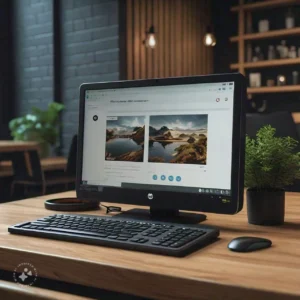Blog Templates: The one important factor in developing a blog that is unique and different from the rest lies in the selection of a WordPress Theme for the Blog. The template you choose determines how your site will look, and its functionality as well so picking the right one is essential to ensure a good user experience (and yes it goes deeper than just looking pretty). In this post, we’ll cover everything you need to know about WordPress blog templates from the basics to pro tips that keep your magnetizing intent-based beautiful as well as user-friendly.
What are WordPress Blog Templates?
WordPress blog templates, or themes, are a predefined array of personalization and styling fixes that administer the looks as well as settings of your site. From the content layout to color scheme, typography, and beyond.
Benefits of having a blog with WordPress
1. User-Friendly Interface
Everyone knows that WordPress is very popular for its easy-to-use user interface. Beginners can learn how to navigate and run their blogs with little knowledge of the technical stuff.
2. There are tons of customization options
WordPress provides you with a wealth of themes and plugins that change the way your blog looks or works. Such flexibility means that you can make an individual site suitable for the specified needs.
3. SEO-Friendly
Built-in SEO optimization of WordPress Most themes have SEO elements built-in, and there are also numerous plugins you can use to improve search engine optimization as well.

Things to look for in a WordPress Blog Template
1. Responsive Design
Web template with responsive design means our blog will be easy to read on everything from a computer, through tablets and smartphones. This is an integral feature to make the user experience uninterrupted and work in support of SEO.
2. Customization Options
So you want to find a template that has lots of options for customization. It offers options like changing colour, fonts, layouts and much more with outdoing code.
3. SEO Optimization
Using SEO optimized templates can work wonders in traffic boosting of your blog. Here, you want to make sure the theme is speed-optimized and lightweight (fast loading time), feature clean code base for best practice in SEO development process; most likely it also comes with support of common-received-sense-seo plugins such as Yoast or All In One seo.
4. Integration with Plugins
Make sure that the template is compatible with some of WordPress popular plugins. This compatibility allows you to add features such as social sharing, contact forms and SEO tools.
Top WordPress Blog Templates
1. Astra
Rating & Votes Pros Cons Price Buy Now Astra is a fast and high-performing WordPress theme that you can use for blogging. Free Get Astra Conclusion. It comes with many pre-built layouts and works well with top page builders like Elementor, Beaver Builder etc.
2. Ocean WP
Ocean WP Ocean WP is also a highly versatile theme designed to cover as many blog niches. It is great for speed, designed in such a way it has already been optimized and customization runs deep.
3. Divi
Divi Divi is a premium theme by Elegant Themes and includes an ultra-advanced drag-and-drop builder. Great for those of you that want full control over the design of their blog.
4. Generate Press
Generate Press – a lightweight and Fast theme This adds many options for customization and support of the major page builders that are on-the-market today.
5. Hestia
Hestia is a contemporary, one-page design with thoughtful creative blogging applications. It has a clean minimalist design and is well-optimized for setting it up fast in the shortest time possible.
How to Add a WP Blog Template
1. Via WordPress Dashboard
Simply login to your WordPress admin area and
Go to Appearance > Themes.
Click on Add New.
Next, search for your theme using the search bar.
INSTALL & ACTIVATE
2. Uploading a Theme
Download the theme’s. zip file.
Step 1: In Your WordPress Dashboard, Go to Appearance > Themes.
We will find Add New then Upload Theme
Choose the. ZIP file and then press Install Now.
Activate the theme.
Design your WordPress Blog Template
1. WordPress Customizer
Go to Appearance > Customize.
Edit settings (site identity, colors & fonts, layout)
PREVIEW CHANGES READY TO PUBLISH.
2. Using Page Builders
Page builders such as Elementor, Beaver Builder and Divi builder provide extensive drag-and-drop functionality for creating some of the most demanding layouts without you getting your elbows sweaty with code.
Optimizing Your Blog for SEO
1. On-Page SEO
Title Tags: Make sure that every post has an original, descriptive title tag
Meta Descriptions-Create a Meta description to make it more exciting for searchers to click through.
Using Madeline-Medium (1)Headers – implement appropriate H1, H2 and H3 tags for your content
2. Technical SEO
Set Speed: Minify Images, Use Caching Plugins and Fast Themes;
Mobile Responsive: Make sure that your theme is responsive and mobile friendly.
XML Sitemaps: Enable sitemap effect use of plugins like Yoast SEO
3. Content Optimization
Step 5 – Keywords: Keyword research and naturally include relevant keywords in your content.
Internal Linking-Link to more Blog post of same Domain.
Top notch Content:- You should focus on delivering quality content which is informative and enjoyable for your readers.
How to Use WordPress Blog Templates (And Tips)
1. Keep It Simple
Don’t pack your blog with too many things. This clean design makes it easy for the user to use as well as highly readable.
2. Prioritize Speed
Opt for a light theme and speed up your site. This is beneficial not only for user experience but also to help increase your SEO rankings.
3. Regular Updates
To protect your site and keep it running smoothly, make regular updates to your theme and plugins. Each time the patches appear on Nintendo Switch, it brings new features and improvements.
4. Backup Your Site
Never forget to take backup of your website away from data loss. The solution is simple, use plugins for automated backups like Up draft Plus.
5. Monitor Performance
Regularly track your site performance via Google Analytics or Search Console You can take this data and use it to make informed decisions for bettering your blog.
Common Mistakes to Avoid
1. Ignoring Mobile Users
Over 50% of web traffic is on mobile devices, thus the importance of selecting a responsive theme that has an awesome user experience for those viewing your site from their phone.
2. Overlooking SEO
Use a theme that is SEO-friendly and install among the plugins to make your life easier. Poor SEO will destroy your visibility.
3. Picking a Theme for the Aesthetic
Aesthetics is key but it should not overshadow the functionality and performance. Select a theme which is the combination of both
4. Not Utilizing Plugins
For a range of essential and user-friendly features, plugins are the way forward for you blog. But refrain from getting too many plugins as they can slow your site.
7 Must Apply Tips for WordPress Blog Templates
1. Child Themes
Create a child theme if you plan to modify it heavily. So you get to update the parent theme without losing what GO did.
2. Custom CSS
Tweak the design of your theme through custom CSS. Custom CSS – A lot of themes give you the option to enter Custom CSS from within your WordPress customizer.
3. Theme Frameworks
One of the things you might want to use instead is a theme framework such as Genesis. For example, the foundation of a framework is provided to ensure that it will be customizable.
4. Multilingual Support
For an international audience, choose a theme that is compatible with multilingual plugins such as WPML or Polylang.
5. Accessibility
The best thing you can do with respect to accessibility is make sure your theme complies with these standards. This is to ensure that everyone can access your blog, including people with disabilities.
Conclusion
Picking out the best possible WordPress blog template is key to a successful blogging venture. By taking into account matters such as responsiveness, customization options and SEO optimization — you can choose a name that looks good, but also increases the performance of your blog. Don’t forget to keep your site fresh, monitor its performance and concentrate on producing USEFUL stuff for the readers. A proper template and practices can give your blog in WordPress reach to a marked audience.
FAQs
1. Choosing the right WordPress blog template for your niche?
Create goals for your blog and know exactly who you are talking to. Find templates that provide feature of your niche or brand style.
2. Is it possible to change the WordPress blog template after a set-website is live?
Yes, you can changes it template any times. That said, sometimes you might have to make some modifications in order to keep your site working and look the way it does now.
3. Can you really use free WordPress themes for a professional blogs?
This is great, especially for starters because you can have free templates. But exclusive/elite templates give additional facilities like premium support and regular updates
4. How To Create Distinctive WordPress Blog Template
Use WordPress Customizer to customize your template and work with page builders, as well as custom CSS. You can have unique and manipulative images, logos & branding elements as well
5. Q: What should I do if my WordPress blog template is slow?
It compresses images, uses caching plugins and lightweight theme to let your site optimize. Maintain Speed and Performance OF Your Website




